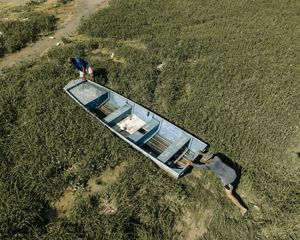Rooted in Tradition
For Indigenous and traditional communities in the Amazon, working with nature is both a livelihood and a way of life.
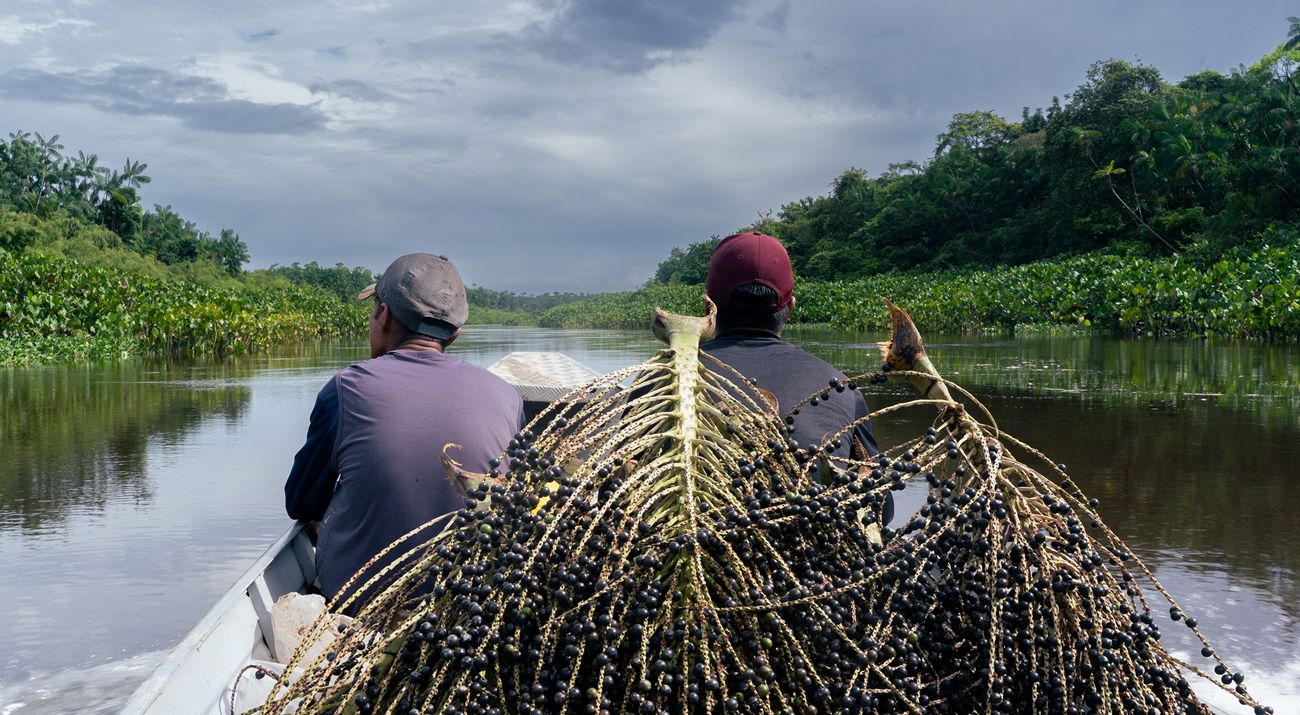
“Açaí is life for us, it's blood,” says Tairene Karipuna.
Karipuna is one of the four ethnic groups that are members of UASEI, an Indigenous cooperative in Oiapoque, Brazil. For countless generations, Indigenous communities here and in other parts of Brazil have eaten the berries of the açaí palm.
Today, açaí is at the center of a series of businesses that UASEI has built to support the financial livelihoods of Indigenous families and help preserve their cultural heritage. That includes using traditional açaí harvesting techniques that avoid any harm to the forests where they grow.
“We don't cut down nature to plant açaí,” Karipuna says. “Just as she is strengthening us and giving us her nourishment. We take care of her so that she can help us.”
This reciprocal relationship with nature is shared by many Indigenous and traditional communities across the Amazon region of South America. It reflects both a spiritual relationship with nature and a practical one. In preserving the forest, they ensure the açaí and other plants critical to their livelihoods are available long into the future.
Our global insights, straight to your inbox
Get our latest research, perspectives and solutions to today’s sustainability challenges.
Sign UpHowever, the future of that forest is under threat. As unsustainable land use, such as poorly managed agriculture, depletes the Amazon’s trees, the biome could soon tip from being one of the world’s largest carbon sinks to a source of carbon emissions—which would have disastrous effects for the global climate.
The growing number of Indigenous and community-owned businesses, based on traditional practices and grounded in self-governance of their territories, could change this trajectory. They offer an alternative economic model that is more empowering for Indigenous and traditional communities, and more sustainable for nature.
Across the region, The Nature Conservancy is working with partners and communities to create the conditions for a thriving, forest-based economy that benefits people and nature. These collective efforts have the power to reshape the future of the Amazon.
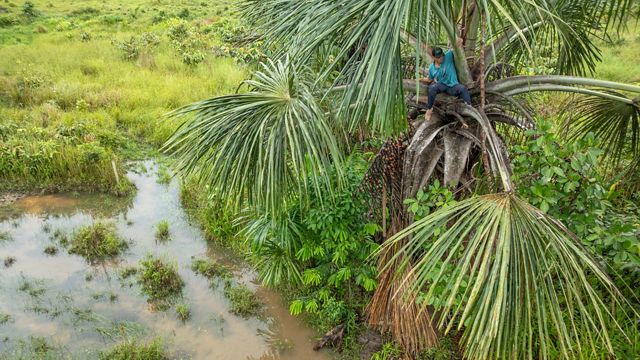
The Amazon—past, present and future
The Amazon Rainforest spreads across nine countries in South America, covering nearly 40% of the continent. It represents a third of the world’s tropical rainforest and holds 10% of the world’s biodiversity. It also stores more than 120 billion tons of carbon in its plants and soil—the equivalent of 15-20 years of global carbon emissions.
But the Amazon is not just untouched wilderness. The region is home to 30 million people, including over 2 million Indigenous peoples. And for these Indigenous communities, the forest has long been the source of their livelihoods. Plants like açaí, cocoa and other fruits and nuts are both traditional foods and, increasingly, the source of products they sell.
These plants are native to the forest, providing food and shelter to wildlife, and often their nuts and fruits can be harvested using traditional processes aligned with natural growth cycles, making their products more sustainable. But they are also more than just a food or product—for many communities they are part of their cultural and spiritual heritage.
“Each plant has its own spirit, and the canangucha’s is a potent and ancient one,” says Irma García, an elder in El Quince Reservation in the Solano municipality in the Upper Caquetá region of Colombia.
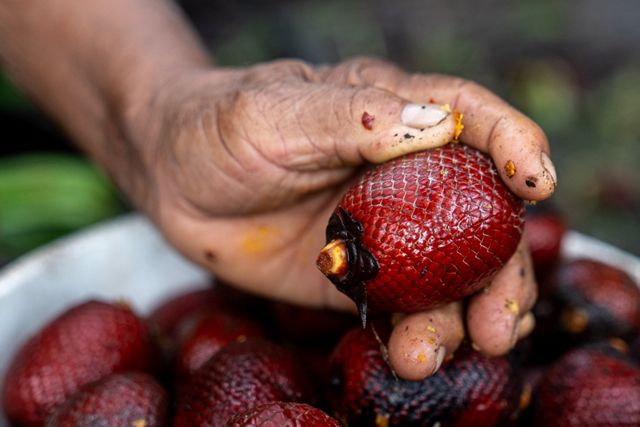
The people of El Quince have used the red fruit of the canagucha palm for generations to treat fevers and other medical conditions, and to brew ceremonial beverages that are consumed when the community gathers to hear the words of the elders and communicate with the spirits of the forest.
But today the Amazon and the communities it supports face urgent pressures.
As much as 20% of the biome has been cleared since 1970, and further areas have been degraded. Deforestation, illegal mining, unsustainable agriculture—especially cattle ranching—pollution and climate change are reshaping its landscapes and waters, putting its rivers, forests and Indigenous communities at increasing risk.
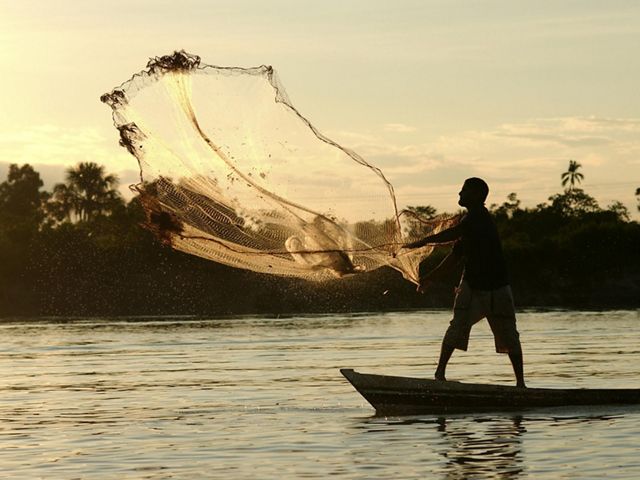
The Rhythm of the Rivers
Climate change is altering water cycles within the Amazon basin—a challenge for Indigenous and traditional communities who rely on its rivers for food, transit and connection. Learn more about how they’re adapting to a new climate reality.
“Our current economic models are major drivers of the loss of carbon storage, of deforestation, loss of biodiversity, infringement on human rights, as well as the extraction of value away from local producers and local communities,” says Lisa Ferguson, director of regenerative economies for TNC. “And we are seeing the effects—in a warmer planet, and in places we knew as children being gone, or changed.”
The socio-bioeconomy: supporting communities and nature
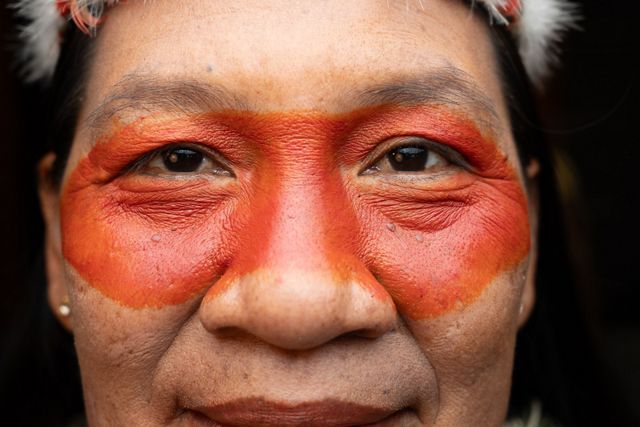
The question is, can traditional livelihoods offer a viable economic model that supports communities’ financial needs and protects nature?
An emerging body of research and community examples from across the region both say the answer is yes. TNC refers to this concept as the socio-bioeconomy—an integrated approach to economic development that values the diversity and well-being of people and nature.
A recent study by TNC and partners in the Amazonian Pará state of Brazil shows how this model can provide better community, ecological and financial benefits. Pará contains 20% of the Amazon rainforest—but it also accounts for 40% of the deforestation across all of Brazil, largely driven by poorly managed cattle ranching.
Previous economic data found that cattle ranching in Pará generates R$4.25 billion every year—more than twice the R$1.9 billion that Indigenous and local communities created through forest products like açaí and cocoa, according to Brazilian Institute of Geography and Statistics (IBGE) data, in 2019.
However, the IBGE data only looked at the value of the initial production—they didn’t account for the value generated by local processing industries or product sales both within and outside of Pará. Taking these elements into consideration, TNC proposed a new methodology to capture the full value generated by the forest products within the state of Pará, estimating an annual contribution of R$4.24 billion—almost as much as cattle ranching.
And given the growing global demand for products like açaí and cocoa, non-timber forest products could soon be more valuable than ranching, especially when we add the ecosystem services provided by the forest, such as carbon storage.
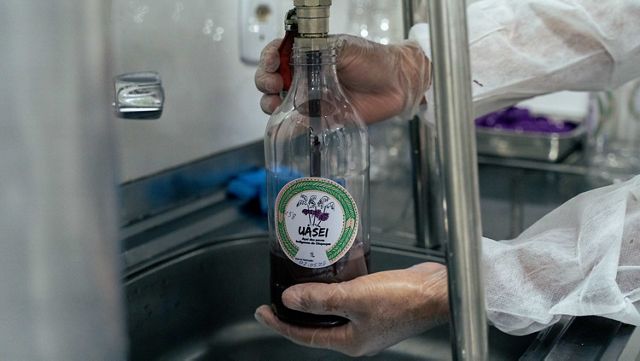
In Brazil, the indigenous cooperative in Oiapoque UASEI operates a small-scale açaí processing facility within their territory.
Cattle Traceability
Unsustainable cattle ranching is a major driver of deforestation—but it doesn't have to be. A new initiative in the Pará state of Brazil traces beef cattle every step of their lives to prevent deforestation. > See how this initiative can prevent deforestation
“In fact, TNC’s study estimates that with the right financial incentives and public policies to support rural production, these products could be generating R$170 billion by 2040, boosting local economies and improving the lives of communities,” explains Juliana Simoes, Indigenous Peoples & local communities strategy deputy manager at TNC Brazil.
Besides being environmentally sustainable, the socio-bioeconomy system is driven by the region’s Indigenous and traditional communities. More of the financial benefits of these businesses stay within the local communities—especially when those communities own the processing and distribution businesses, not just harvesting.
And many of these businesses help to preserve cultural traditions that value and protect the rainforest and other landscapes—ensuring nature thrives and planet-warming carbon remains locked up in healthy plants and soils.
Indigenous and community leadership across the Amazon
The socio-bioeconomy is not just an abstract concept—Indigenous and traditional communities across Brazil, Colombia, Ecuador and other Amazonian countries are showing how this system can work.
In Colombia’s Solano municipality, the Association of Murui Muina Town Councils of the Upper Caquetá basin (ASCAINCA in Spanish)—formed by the communities of the Aguas Negras, Huitora, Coropoya, El Quince and Ismuina—have started a new business known as Kabure. Kabure—meaning “breath of life”—sells juices, pulps and jams made from the canangucha and other native fruits.


In Ecuador, the Kichwa people of Rukullakta have been developing an aquaculture program raising native fish as an alternative to tilapia, which is commonly farmed but is invasive to the region and can threaten freshwater habitats when they escape. The community is also planting wayusa, a native plant typically brewed to make tea that is high in caffeine and antioxidants.
The community is also experimenting with service industries like community eco-tourism to create a greater variety of business opportunities for young people, says Samuel Chihuango, the kuraka, or leader of the Kichwa. “We’re seeking alternatives, because our youth is migrating away from the territory."
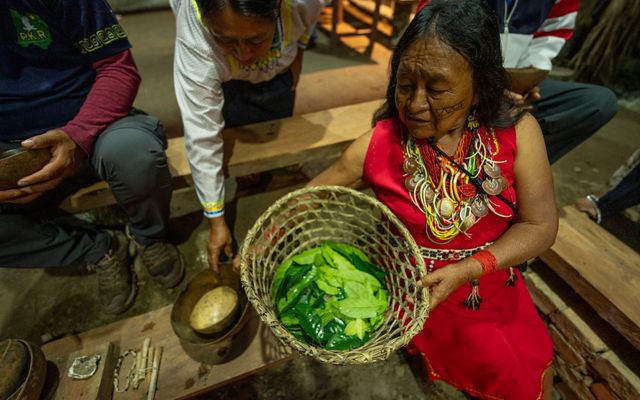
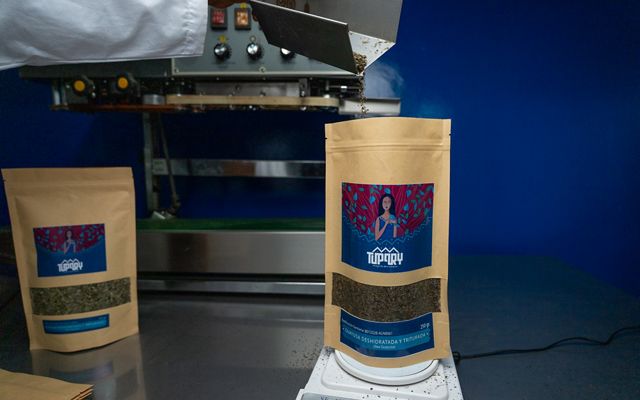
Amazonia Forever Program
Many communities have viable business models but lack the tailored financial instruments that can help them move from small-scale pilots to sustainable enterprises. To address this gap, TNC and IDB Invest, under the Amazonia Forever Program, have developed a Good Practice Note: “Building a Sustainable and Equitable Socio-bioeconomy in the Amazon: A Good Practice Guide for the Private Sector” that provides the private sector with clear principles for investing responsibly in the socio-bioeconomy. This guidance can help channel more capital to Indigenous- and community-led businesses in ways that respect rights, reduce risks and unlock long-term value.
New opportunities bring new challenges
Building a strong socio-bioeconomy requires more than vision. Many communities need capacity building and technical assistance to turn their knowledge and resources into profitable enterprises. They also need access to markets and to financing that matches their level of development, ensuring they can scale sustainably and equitably. And all of this depends on supportive public policies that protect rights and foster innovation. Together, these elements create the conditions for people and nature to thrive.
The starting point must always be supporting Indigenous communities to achieve and maintain tenure rights to their territories—and the ability to self-govern within their territories. Any kind of economic endeavor needs to be aligned with the local community’s vision and in agreement within the community on how they want to manage their territories and develop their natural resources.
TNC has been working with Indigenous communities in the Amazon for over ten years to secure rights to their lands and create territorial management plans for resource governance, including mapping what natural resources they have that could support new businesses.
Other communities may have clear resource plans and established businesses that sell locally but need assistance scaling their operations. UASEI is one example. The Oiapoque are already the only Indigenous Land in Brazil to operate a small-scale açaí processing facility within their territory. But UASEI hopes to expand its production to meet the growing international demand for açaí—which would also reduce their dependence on intermediaries and allow them to invest more in local development.
Recognizing that they could only harvest fresh açaí for five months of the year, the organization recently started freeze-drying the pulp, which can be used in many products. They have found some local buyers for the freeze-dried product, but there is far more potential in the international market—if they can scale their production and meet standards for safety.
“In ten years' time, I want UASEI to be transporting freeze-dried açaí nationally and internationally,” says Diese Felicio Batista Palikur, treasurer of UASEI.
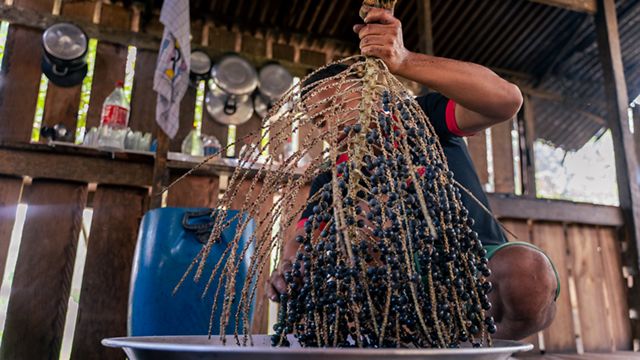
Building a sustainable and equitable socio-bioeconomy
The challenge now is ensuring that the many socio-bioeconomy initiatives across the Amazon can grow with the scale required to meet the needs of Indigenous and traditional communities—and at the speed required to meet the urgency of the climate crisis.
TNC is working not only to support initiatives on the ground, but also to strengthen key public policies—such as the National Policy for Environmental and Territorial Management of Indigenous Lands (PNGATI), Brazil’s main Indigenous policy aimed at ensuring well-being and territorial protection. TNC’s collaboration with the COIAB Network (Coordination of Indigenous Organizations of the Brazilian Amazon) has accelerated this work across the Amazon, creating the conditions that have allowed organizations such as UASEI to form and flourish.
“For the socio-bioeconomy to have maximum impact will require more investment. I often say science is doing its part, [and] society is doing its part. Those who have to do their part are governments and companies,” says Marina Silva, Brazil’s Minister for the Environment and Climate Change.
That issue will likely be front and center at this year’s UN climate conference (COP30), held in Belém, Brazil—a city known as “the Gateway to the Amazon.” While policymakers are increasingly aware of the importance of Indigenous communities for protecting nature and fighting climate change, “we are not always matching that with actual investment in these people,” says Leticia Cobello, TNC’s program lead for the Amazon Collective Territories in Brazil.
“The socio-bioeconomy is a potential solution,” Cobello adds, “but only if we have support for governance and land rights so communities can stay on their lands and thrive."
That public support will be crucial. But the most important thing is still leadership and examples coming from within the Indigenous communities themselves.
Quote: Sebastián Vargas
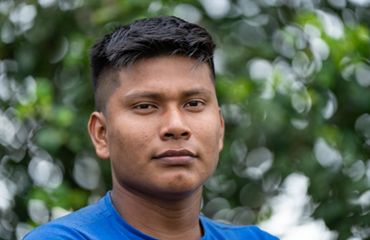
We want to show that we, Indigenous Peoples, can also have our own businesses, following the principles of our culture, our management, our traditions, without losing sight of our purpose, which is to protect nature to keep the planet alive.
